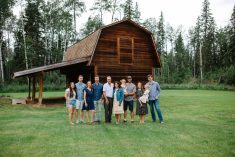Family ties and farming operations have long been intertwined. Indeed, family forms the backbone of many of our agricultural traditions, and today, it is often the reason why navigating farm succession is so complex.
In fact, we can say even more. In an important way, family is making succession planning even more difficult in 2024 than in the past. That’s because no matter what sector you’re involved in this year, the topic of what is fair for our non-farming children is plaguing our parents.
The consistent rise in farmland values has further increased this burden and many farm families are looking for solutions that will address the discrepancy in equity that can be caused by the inflated value of their farming assets.
Read Also

What to consider when setting up farm-related business ventures
Things to consider before launching a farm-adjacent side business.
This is why many farm owners are considering splitting their farmland among all their children — both the farming and the non-farming children — in an attempt to be as equal as possible. Then, to prevent the farm suffering after losing its land base, these families are opting for family rental agreements to allow the farm operation to continue to leverage family assets, even if these assets have fallen out of the hands of the farm operators.
However, when it comes to farmland rental agreements between family members, a seemingly harmonious arrangement can give rise to unexpected challenges.
Yes, the concept of keeping land within the family may seem appealing, but there are several downsides that often go unnoticed. In this article, we will explore the potential risks associated with family farmland rental agreements and hopefully shed light on the complexities that can emerge.
Any succession plan that requires the non-farming children to rent to their farming sibling(s) must be looked at with your eyes wide open.
Strained family relationships
One of the most significant downsides of family farmland rental agreements is the potential strain it can place on familial relationships. Mixing business with family dynamics can lead to misunderstandings, disagreements, and, in extreme cases, permanent damage to family bonds.
Disputes over rental terms, land use, or financial matters can create rifts that extend beyond the realm of the business agreement, affecting the overall harmony of the family.
Parents know their children so they know that disagreements do occur and they are sometimes difficult to sort out. To prevent this, the primary strategy that parents go for is to produce detailed, and thorough agreements.
However, these agreements can often feel like being “managed from the grave” and the benefits of the inheritance can seem to become muted if the terms of the arrangement are forced on the parties.
It is also often more difficult to build working agreements with parties who are not present in the daily operations of the business. Those more removed from the daily duties of the farm may struggle to see the bigger picture when it comes to land maintenance and improvements, and this can complicate the working relationship between the siblings.
Ambiguity in agreements
Unlike formal leasing arrangements with non-family entities, family farmland rental agreements may lack the clarity and specificity needed to prevent future conflicts.
Family members often assume mutual understanding and trust and they may not invest the necessary time and effort in drafting a comprehensive agreement.
This may also be because, in an attempt to maintain the status quo and family harmony, they don’t want to go into the necessary depth around controversial or difficult topics such as death, divorce and disability, any of which could have an impact on the validity of potential agreements.
The resulting ambiguity can give rise to disputes regarding responsibilities, expectations, and even the duration of the rental agreement, and, in turn, become a detriment to the family harmony that this process was designed to enhance.
Unequal contributions and benefits – the ‘sweat equity’ factor
Family members typically have different levels of involvement in and commitment to the farming operation. This can lead to unequal contributions and benefits, causing resentment among family members.
For instance, if one party invests more time, effort or resources into the farm than the other(s), feelings of inequity may arise, jeopardizing the sustainability of the rental agreement and succession in general.
Sometimes we cross the line of trying to be too fair to our non-farm children and, as a result, the balance shifts to now being unfair to those who have shown their commitment to the farm and its operations.
Using a rental agreement as the basis for equalization can indeed have strong merit. However, if we don’t first address some of the underlying, deeper-rooted issues in the family dynamic we are often just deferring potential conflict instead of solving the problem.
Financial strain
Farming is an unpredictable business subject to many external influences such as weather and market fluctuations. In this context, family farmland rental agreements may not provide the financial stability that non-family arrangements can offer.
As well, economic hardships on the farm may place strain on family relationships as financial challenges spill over into personal matters. What if the farm is having a tough year and can’t make the rent payments?
This is a big enough problem when working with non-family entities but becomes another issue altogether when there are now multiple family members who become financially affected, all of whom may be relying on the revenue generated by the rental contracts.
The other aspect that is often not considered is what happens if there is an eventual sale of the land. Who sets the terms? Can the farm handle losing the rental land, or does it now need to investigate buying out the land? These questions can place considerable strain on sibling relationships.
Inability to adapt to changing circumstances
Life is dynamic. Circumstances can change unexpectedly. Family farmland rental agreements may lack the flexibility needed to adapt to evolving family structures, economic conditions, or changes in farming practices.
Without the ability to modify the agreement to suit the current needs of the family and the farm, the arrangement may become unsustainable in the long run. A prime example of this could be the change in employment status of the new landowner — who, in this case, would be a non-farming child.
If, suddenly, the landowner was unable to work, then they may need to unlock the value of the land they own to fill the gap in their lifestyle needs. This can have a multitude of negative impacts on both the family and farming operation.
If the landowner does indeed need to sell the land, then either the farming children must find the funds needed to purchase the land from their sibling, or the land will be lost to an outside party and the farm will lose both equity and ability to generate income. Either of these outcomes results in significant financial strain for the parties involved.
Conclusion
While the idea of keeping farmland within the family is rooted in tradition and a desire for continuity, family farmland rental agreements come with their own set of challenges. From strained relationships to succession planning complexities and financial strain, the downsides are manifold.
It is crucial for families considering such arrangements to approach them with a clear understanding of the potential pitfalls and to seek professional guidance in creating comprehensive, transparent agreements that protect both the family and the farm.
Balancing the business aspects with the emotional connections to the land is essential for fostering a sustainable and harmonious future for both the family and the farm.
These family farmland rental agreements can indeed fill a void in the succession planning efforts for farming families, but the creation of these agreements should not be taken lightly.
In our practice as succession planners, it is imperative that we fully understand the vision of success for the families we work with so the agreements truly align with the long-term goals of both the farm and the family. This includes the non-farming children.
Structuring these agreements to fit into a larger comprehensive plan for farm succession as opposed to being the primary solution will not only benefit the farming operation, but also place less burden on the family members which it seeks to protect.
– This article was originally published in the Feb. 27, 2024 issue of Country Guide.















